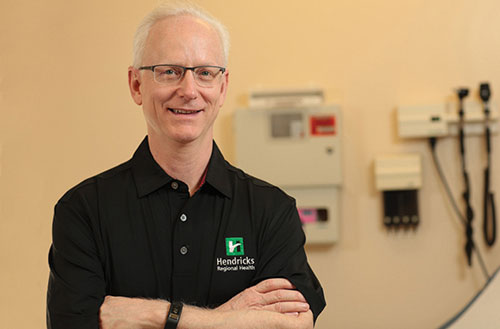
As medical advisor for DePauw Health and head team physician for DePauw University, Dr. David Harsha spent his summer in a mask for 8-10 hours a day—a mandatory precaution for medical providers across the country. Harsha’s work as a medical professional has helped DePauw run on a hybrid status, ensuring a safe opening to campus this Fall.
Dr. David Harsha is the medical director for Depauw Health and head team physician for Depauw University. Over the summer, he was one of the prominent members of the DePauw community that helped navigate the global pandemic we live in and come up with an action plan.
As a healthcare worker, he does not have a choice but to wear a mask for long hours in order for himself and others around him to stay healthy. His work involved responding first-hand to calls discerning symptoms of COVID-19.
Along with his advisory work on DePauw’s coronavirus plan, Harsha also worked with various other teams to manage the new developments and changes on DePauw’s campus. He points out that the Health and Wellness Center is no longer at the back of Hogate (which has been demolished) but located in Lily. He was also part of the crisis intervention management team, a committee devised to develop safety protocols on campus.
“I provided medical input on protocols as well as guidelines that were developed and put out by the CDC as well as the Indiana State department of Health and worked with local Putnam county health department to look at what measures we needed to take for employees and people to come back to campus,” Harsha said in response to how the team put together a line of action.
The combined efforts of Harsha and the medical staff has enabled campus to be re-opened for this Fall. Monitoring the rapidly changing situation was a tenuous task that required a network of contingency plans before the team could publish a website listing recommendations and FAQ’s for navigating COVID-19 on campus. All of this occured over the summer. “We are working hard to stay abreast of those rapid changes,” Harsha said.
The protocols included handwashing stations, testing on campus, arranging for quarantine houses in case of an outbreak and anything, mask use. While working on all of this, Harsha comments that, “Our biggest goal is to keep things sustainable on campus. ” One of the primary steps of the recommendations are for students to educate themselves on symptoms which include:
- Cough
- Shortness of Breath
- Severe Headache
- Fever
- Loss of smell
- Muscle ache
- Fatigue
- Sore throat
- Chills
Based on the knowledge of these symptoms, the students should monitor themselves on a daily basis and contact DePauw Health if they do feel any symptoms. Students need to keep in mind that they should call first before physically showing up because to reduce exposure to those already sick. To help facilitate this, the health center will offer check-ins to the students, lowering the risk of contagion. Testing is also available on campus.
While prevention measures are extensive, masks are a top priority. The virus spreads through saliva droplets, making masks extremely effective in preventing the spread.
“We really want people to wear masks pretty religiously,” Harsha said. In a required COVID-19 safety course from the university, Dr. Harsha explicitly models how to wear a mask correctly. “Don't succumb to the fatigue factor and start throwing you masks in the drawer,” Harsha said.
Along with wearing a mask, students should also maintain a six foot distance from other people, specially indoors, as indoor spaces are more risky when it comes to contracting the virus.
DePauw supplies three free, washable masks to students on campus, so that acquiring a mask is not a hindrance in anybody’s safety.
“When you are wearing a mask, you are protecting others and when others wear a mask, they protect you so when everybody’s wearing a mask, we’re having a 'we moment',” Harsha said.
All around campus, handwashing stations have been installed to ensure maximum safety and it is recommended to wash hands after touching surfaces like doorknobs, handles, etc. Classrooms and all other communal spaces have been arranged so that people are 6 feet apart and practice social distancing.
Despite all of the new protocols, staying socially distant does not mean students cannot be social.
“I would encourage everyone to stay connected as best as they can while following all the health practices,” Harsha said.
